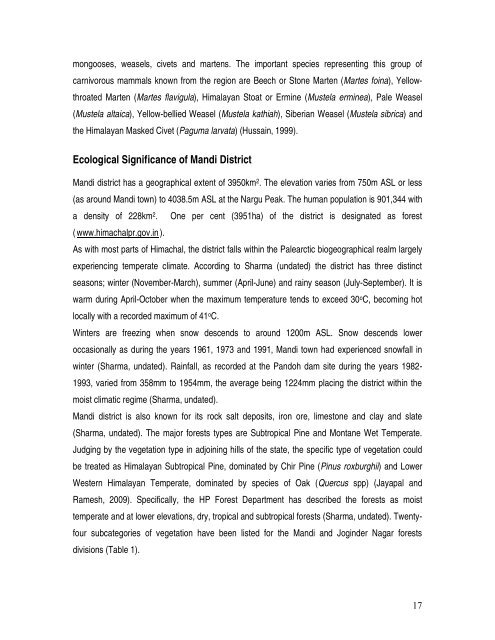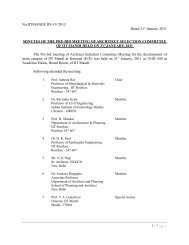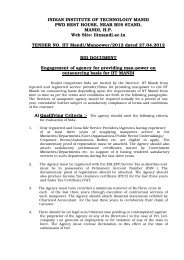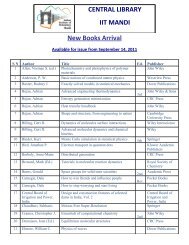Eco Report of the area - IIT Mandi
Eco Report of the area - IIT Mandi
Eco Report of the area - IIT Mandi
Create successful ePaper yourself
Turn your PDF publications into a flip-book with our unique Google optimized e-Paper software.
mongooses, weasels, civets and martens. The important species representing this group <strong>of</strong><br />
carnivorous mammals known from <strong>the</strong> region are Beech or Stone Marten (Martes foina), Yellowthroated<br />
Marten (Martes flavigula), Himalayan Stoat or Ermine (Mustela erminea), Pale Weasel<br />
(Mustela altaica), Yellow-bellied Weasel (Mustela kathiah), Siberian Weasel (Mustela sibrica) and<br />
<strong>the</strong> Himalayan Masked Civet (Paguma larvata) (Hussain, 1999).<br />
<strong>Eco</strong>logical Significance <strong>of</strong> <strong>Mandi</strong> District<br />
<strong>Mandi</strong> district has a geographical extent <strong>of</strong> 3950km 2 . The elevation varies from 750m ASL or less<br />
(as around <strong>Mandi</strong> town) to 4038.5m ASL at <strong>the</strong> Nargu Peak. The human population is 901,344 with<br />
a density <strong>of</strong> 228km 2 . One per cent (3951ha) <strong>of</strong> <strong>the</strong> district is designated as forest<br />
(HUwww.himachalpr.gov.inUH).<br />
As with most parts <strong>of</strong> Himachal, <strong>the</strong> district falls within <strong>the</strong> Palearctic biogeographical realm largely<br />
experiencing temperate climate. According to Sharma (undated) <strong>the</strong> district has three distinct<br />
seasons; winter (November-March), summer (April-June) and rainy season (July-September). It is<br />
warm during April-October when <strong>the</strong> maximum temperature tends to exceed 30 o C, becoming hot<br />
locally with a recorded maximum <strong>of</strong> 41 o C.<br />
Winters are freezing when snow descends to around 1200m ASL. Snow descends lower<br />
occasionally as during <strong>the</strong> years 1961, 1973 and 1991, <strong>Mandi</strong> town had experienced snowfall in<br />
winter (Sharma, undated). Rainfall, as recorded at <strong>the</strong> Pandoh dam site during <strong>the</strong> years 1982-<br />
1993, varied from 358mm to 1954mm, <strong>the</strong> average being 1224mm placing <strong>the</strong> district within <strong>the</strong><br />
moist climatic regime (Sharma, undated).<br />
<strong>Mandi</strong> district is also known for its rock salt deposits, iron ore, limestone and clay and slate<br />
(Sharma, undated). The major forests types are Subtropical Pine and Montane Wet Temperate.<br />
Judging by <strong>the</strong> vegetation type in adjoining hills <strong>of</strong> <strong>the</strong> state, <strong>the</strong> specific type <strong>of</strong> vegetation could<br />
be treated as Himalayan Subtropical Pine, dominated by Chir Pine (Pinus roxburghii) and Lower<br />
Western Himalayan Temperate, dominated by species <strong>of</strong> Oak (Quercus spp) (Jayapal and<br />
Ramesh, 2009). Specifically, <strong>the</strong> HP Forest Department has described <strong>the</strong> forests as moist<br />
temperate and at lower elevations, dry, tropical and subtropical forests (Sharma, undated). Twentyfour<br />
subcategories <strong>of</strong> vegetation have been listed for <strong>the</strong> <strong>Mandi</strong> and Joginder Nagar forests<br />
divisions (Table 1).<br />
17
















